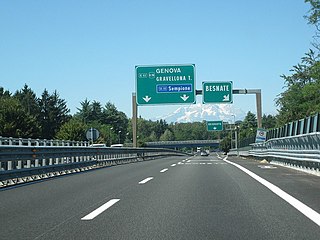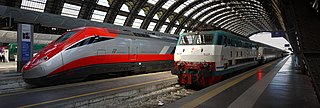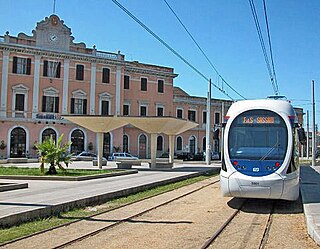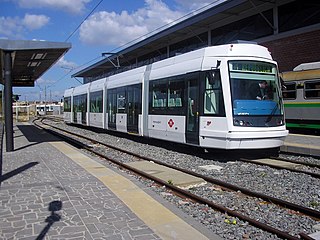
Italy has a well developed transport infrastructure. The Italian rail network is extensive, especially in the north, and it includes a high-speed rail network that joins the major cities of Italy from Naples through northern cities such as Milan and Turin. The Florence–Rome high-speed railway was the first high-speed line opened in Europe when more than half of it opened in 1977. Italy has 2,507 people and 12.46 km2 per kilometer of rail track, giving Italy the world's 13th largest rail network. The Italian rail network is operated by state-owned Ferrovie dello Stato, while the rail tracks and infrastructure are managed by Rete Ferroviaria Italiana.

The Italian railway system is one of the most important parts of the infrastructure of Italy, with a total length of 24,567 km (15,265 mi) of which active lines are 16,832 km (10,459 mi). The network has recently grown with the construction of the new high-speed rail network. Italy is a member of the International Union of Railways (UIC). The UIC Country Code for Italy is 83.

The Finnish railway network consists of a total track length of 9,216 km (5,727 mi). Railways in Finland are built with a broad 1,524 mm track gauge, of which 3,249 km (2,019 mi) is electrified. Passenger trains are operated by the state-owned enterprise VR that runs services on 7,225 km (4,489 mi) of track. These services cover all major cities and many rural areas, though the coverage is less than the coverage provided by the bus services. Most passenger train services originate or terminate at Helsinki Central railway station, and a large proportion of the passenger rail network radiates out of Helsinki. VR also operates freight services. Maintenance and construction of the railway network itself is the responsibility of the Finnish Rail Administration, which is a part of the Finnish Transport Agency. The network consists of six areal centres, that manage the use and maintenance of the routes in co-operation. Cargo yards and large stations may have their own signalling systems.

Rail transport in Greece has a history which began in 1869, with the completion of the then Athens & Piraeus Railway. From the 1880s to the 1920s, the majority of the network was built, reaching its heyday in 1940. From the 1950s onward, the railway system entered a period of decline, culminating in the service cuts of 2011. Ever since the 1990s, the network has been steadily modernized, but still remains smaller than its peak length. The operation of the Greek railway network is split between the Hellenic Railways Organisation (OSE), which owns and maintains the rail infrastructure; GAIAOSE, which owns the building infrastructure and the former OSE rolling stock, Hellenic Train; and other private companies that run the trains on the network. Greece is a member of the International Union of Railways (UIC). The UIC Country Code for Greece is 73.

The Milan–Bologna railway is the northern part of the traditional main north–south trunk line of the Italian railway network. It closely follows the ancient Roman Road, the Via Aemilia. The line was opened between 1859 and 1861 as a single-line railway, and was doubled between 1866 and 1894. It was electrified at 3,000 volts DC in 1938. High-speed trains on the route have used the parallel Milan–Bologna high-speed line since 13 December 2008.

The Ferrovie della Sardegna, known also as ARST Gestione FdS between 2008 and 2010 and with the abbreviation FdS, was an Italian public company that managed the regional railway network in the island of Sardinia, Italy. In 2010 it was totally integrated with the main regional public transport company, ARST.

Metrosassari, also called Sassari tramway, Sassari tram-train or Sassari metro-tramway is the commercial name of a tram-train line in Sassari, Sardinia, Italy, operated by the regional public transport company ARST.

Lucca railway station serves the city and comune of Lucca, in the region of Tuscany, central Italy. Opened in 1846, it forms part of the Viareggio–Florence railway, and is also the junction for lines to Pisa and to Aulla. All of these lines are only served by regional trains.

Cagliari is the main railway station of the Italian city of Cagliari, the capital of Sardinia. It is owned by the Ferrovie dello Stato, the national rail company of Italy, and is the most important station of its region. The station is sometimes unofficially named Cagliari Centrale and Cagliari Piazza Matteotti. This second name is due to the station's position on Giacomo Matteotti Square.

Barletta railway station is the main station serving the city and comune of Barletta, in the region of Apulia, southern Italy. Opened in 1864, it forms part of the Adriatic Railway (Ancona–Lecce), and is also a junction station for two other, regional, lines, the Barletta–Spinazzola railway, and the Bari–Barletta railway, operated by Ferrotramviaria.

Catanzaro, commonly known as Catanzaro Sala for the position in Sala quarter and due to the name of the adjacent FC station, is a railway station of the Italian city of Catanzaro, in Calabria region.

Siracusa is the main railway station of the Italian city of Syracuse, in Sicily. Like Palermo Centrale, Catania Centrale and Messina Centrale it is one of the most important stations in Sicily. It is owned by the Ferrovie dello Stato, the national rail company of Italy.

Matera Centrale is the main railway station in the Italian town of Matera, in Basilicata. It is owned by the Ferrovie Appulo Lucane (FAL), a private company based in Bari, and is the nearest station to the Sassi.

Olbia railway station serves the town and comune of Olbia, in the northeast of the island and region of Sardinia, Italy. Opened in 1881, it forms part of the Cagliari–Golfo Aranci railway, the main railway line in Sardinia.

Avellino is the main railway station of the Italian city of Avellino, in the region of Campania. It is owned by the Ferrovie dello Stato, the national rail company of Italy, and is classified Silver.

The Cagliari light rail system, commercially known as Metrocagliari, is a two-line light rail system that serves the town of Cagliari and part of its metropolitan area, in Sardinia, Italy. The system was inaugurated in 2008 and has subsequently been expanded to two lines.

Most narrow-gauge railways in Italy were built with Italian metre gauge, which is actually 950 mm because historically the Italian track gauge was defined from the centres of the rail instead of the internationally accepted method of measuring the gauge from the inside edges of the rails. Several metre-gauge lines were built in northern Italy.

Trams in Linz is a network of tramways forming the backbone of the urban public transport system in Linz, which is the capital city of the federal state of Upper Austria in Austria.

Il Trenino Verde della Sardegna is a rail tourism service operated by ARST in the island of Sardinia, Italy.

The railway network of Sardinia includes lines that develop for a total of about 1,038 km in length, of which 430 km with an ordinary gauge and about 608 km narrow gauge, with an average density of 43 m of rail per km2, a figure that drops to 25 m/km2 considering only public transport lines.





















